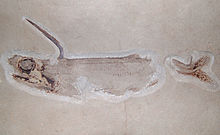Falcatus
| Falcatus Temporal range: Middle Viséan - Late Serpukhovian
| |
|---|---|

| |
| Specimen in Vienna | |
| Scientific classification | |
| Domain: | Eukaryota |
| Kingdom: | Animalia |
| Phylum: | Chordata |
| Class: | Chondrichthyes |
| Order: | †Symmoriiformes |
| Family: | †Falcatidae |
| Genus: | †Falcatus Lund, 1985 |
| Species | |
| |
Falcatus is an extinct genus of
Description


This fish was quite small, only getting to around 25–30 cm or 10-12 inches long. This is about as big as some of the smallest sharks around today, like the
Classification
Despite often being called a shark, Falcatus and its relatives were part of the order

Paleoecology
The bear gulch limestone is a fossil deposit from the Big Snowy Mountains of Montana. It is a smaller part of the larger St. louis limestone, which dates to the middle carboniferous. During the time, the area was a series of mudflats and lagoons with brackish and freshwater.[7] Many theories have been put forth for the preservation. One is that the creatures sank to the bottom and died of asphyxiation in the oxygen poor waters, being preserved without scavenging took place.[8] Another theory is that the bottom of the bay created mudslides because of heavy rainfall, which rapidly buried the creatures.[9] However, because many of the fish fossils were found with distended gills, this would suggest death by asphyxiation.[10] Falcatus lived alongside many strange creatures like the chondrichthyans Agassizodus, Listracanthus[11] and Delphyodontos.[12] It also lived alongside many ray-finned fish like Discoserra[13] and Paratarrasius.[14] Other fish included the rhabdodermatid Cardiosuctor,[15] the rhizodont Strepsodus,[16] and Hardistiella, one of the oldest known lamprey.[17] The invertebrates of bear gulch were very diverse creatures, like the hoplocarids, which include modern day mantis shrimp,[18] Anderella, which is the youngest known synziphosurine[19] and more enigmatic creatures like Typhloesus,[20] and the "Square objects" which might be sea salps or cnidarians.[21] Other inverts include, mollusks like the nautiloid Tylonautilus,[22] pterioid bivalves which have been found encrusting sargassum like brown algae[23] as well as productid brachiopods,[24] Paleolimulus,[25] phyllocarids[26] and echinoderms like Crinoids, echinoids, sea stars, brittle stars and a many armed starfish called Lepidasterella montanensis.[27]
References
- David Norman. (2001): The Big Book Of Dinosaurs. Pg.84 and Pg.286, Walcome books.
- ^ "A Golden Age of Sharks". elasmo-research.org.
- ^ "Bear Gulch - Falcatus falcatus". Archived from the original on 2008-08-21. Retrieved 2008-09-04. Fossil Fish of Bear Gulch 2005 by Richard Lund and Eileen Grogan Accessed 2009-01-14
- ^ a b The morphology of Falcatus falcatus (St. John and Worthen), a Mississippian stethacanthid chondrichthyan from the Bear Gulch Limestone of Montana. Journal of Vertebrate Paleontology 5(1):1-19.
- ^ Coates, M., Gess, R., Finarelli, J., Criswell, K., Tietjen, K. 2016. A symmoriiform chondrichthyan braincase and the origin of chimaeroid fishes. Nature. doi: 10.1038/nature20806
- S2CID 3504437.
- S2CID 92392461.
- ^ "Bear Gulch Limestone Fossil Lagerstätte". fossilmuseum.net.
- ISSN 0022-3360.
- ^ Grogan, Eileen D.; Lund, Richard (2002). "The geological and biological environment of the Bear Gulch Limestone (Mississippian of Montana, USA) and a model for its deposition" (PDF). Geodiversitas. 24 (2): 295–315.
- ^ Hagadorn, James W. (2002). "Bear Gulch: An Exceptional Upper Carboniferous Plattenkalk". In Bottjer, D.J.; Etter, W.; Hagadorn, J.W.; Tang, C.M. (eds.). Exceptional fossil preservation; a unique view on the evolution of marine life. New York: Columbia University Press. pp. 167–183.
- S2CID 13249799.
- S2CID 36858963.
- ^ Lund, Richard (2000). "The new Actinopterygian order Guildayichthyiformes from the Lower Carboniferous of Montana (USA)" (PDF). Geodiversitas. 22 (2): 171–206.
- ^ Lund, Richard; Melton, William G. Jr. (1982). "A new actinopterygian fish from the Mississippian Bear Gulch Limestone of Montana". Palaeontology. 25 (3): 485–498.
- ISSN 0016-6995.
- S2CID 14850973.
- ISSN 0272-4634.
- ^ Factor, David F.; Feldmann, Rodney M. (11 October 1985). "Systematics and paleoecology of malacostracan arthropods in the Bear Gulch Limestone (Namurian) of Central Montana". Annals of Carnegie Museum. 54 (10): 319–356.
- ISSN 1475-4983.
- .
- ^ "Description of the 'square objects' of the Bear Gulch Limestone, Montana, USA" (PDF). newhaven.edu.
- ISSN 0022-3360.
- ISSN 0022-3360.
- JSTOR 1303712.
- ^ Schrams, Frederick R. (1979). "Limulines of the Mississippian Bear Gulch Limestone of Central Montana, USA". Transactions of the San Diego Society of Natural History. 19 (6): 67–74.
- JSTOR 1303712.
- JSTOR 1304921.
